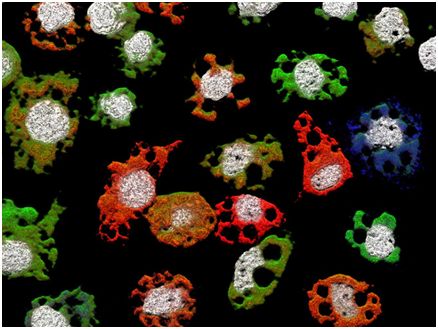
在一项新的研究中,来自美国陆军传染病医学研究所等机构的研究人员发现一种感染蚊子的新型多分体病毒(multicomponent virus):这是首次从一种动物体内分离出的这样的一种病毒。这种新型病毒被研究人员命名为Guaico Culex病毒(Guaico Culex virus, GCXV),它的基因组由5个节段组成,每个节段被单独包装在不同的病毒粒子(virion)中。为了感染蚊子,这种病毒基因组的至少4个节段必需侵入宿主体内。相关研究结果于2016年8月25日在线发表在Cell Host & Microbe期刊上,论文标题为“A Multicomponent Animal Virus Isolated from Mosquitoes”。
澳大利亚悉尼大学病毒学家Edward Holmes(未参与这项研究)说,“这是最为奇特的。如果你将它与人体进行比较的话,它就好比一个人将他/她的腿、躯干和手臂都放在不同的地方。”
他补充道,“随后,所有的节段以某种方式集合在一起,像单分体病毒一样发挥作用。我认为自然界中还没有其他东西以这种方式行动。”
具有多节段基因组的病毒(即多分体病毒)经常感染植物和真菌,但是它们在动物体内是极其罕见的。
这项发现和描述了GCXV的研究是更好理解蚊媒病毒的更广泛努力的一部分。研究人员也在来自乌干达的红疣猴体内发现了这种新型病毒的变异体。不过GCXV似乎并不感染人类。
A Multicomponent Animal Virus Isolated from Mosquitoes
Jason T. Ladner, Michael R. Wiley, Brett Beitzel, Albert J. Auguste, Alan P. Dupuis II, Michael E. Lindquist, Samuel D. Sibley, Krishna P. Kota, David Fetterer, Gillian Eastwood, David Kimmel, Karla Prieto, Hilda Guzman, Matthew T. Aliota17, Daniel Reyes, Ernst E. Brueggemann, Lena St. John, David Hyeroba, Michael Lauck, Thomas C. Friedrich, David H. O’Connor, Marie C. Gestole18, Lisa H. Cazares, Vsevolod L. Popov, Fanny Castro-Llanos, Tadeusz J. Kochel18, Tara Kenny, Bailey White, Michael D. Ward, Jose R. Loaiza, Tony L. Goldberg, Scott C. Weaver, Laura D. Kramer, Robert B. Tesh, Gustavo Palacios
doi:10.1016/j.chom.2016.07.011
PMC:
PMID:
RNA viruses exhibit a variety of genome organization strategies, including multicomponent genomes in which each segment is packaged separately. Although multicomponent genomes are common among viruses infecting plants and fungi, their prevalence among those infecting animals remains unclear. We characterize a multicomponent RNA virus isolated from mosquitoes, designated Guaico Culex virus (GCXV). GCXV belongs to a diverse clade of segmented viruses (Jingmenvirus) related to the prototypically unsegmented Flaviviridae. The GCXV genome comprises five segments, each of which appears to be separately packaged. The smallest segment is not required for replication, and its presence is variable in natural infections. We also describe a variant of Jingmen tick virus, another Jingmenvirus, sequenced from a Ugandan red colobus monkey, thus expanding the host range of this segmented and likely multicomponent virus group. Collectively, this study provides evidence for the existence of multicomponent animal viruses and their potential relevance for animal and human health.

